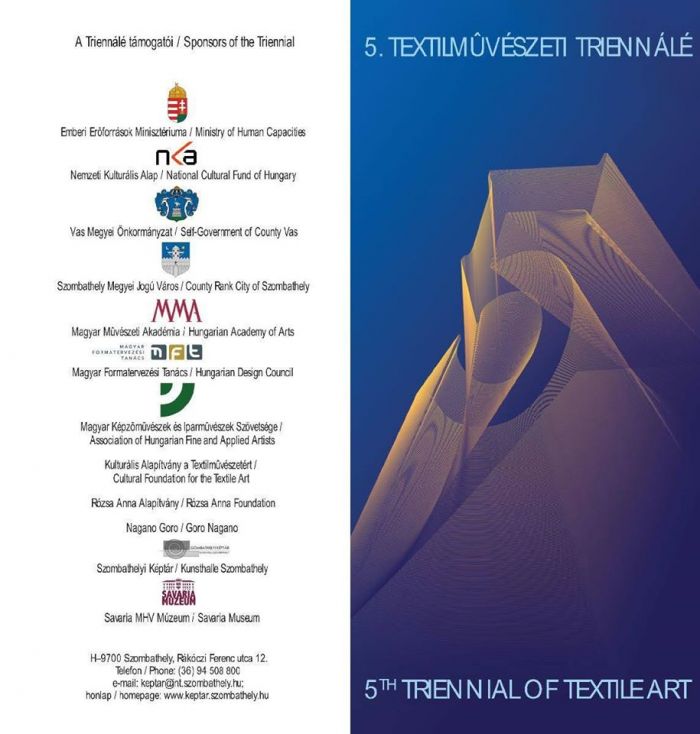IMAGO

A Szombathelyi Képtárban megrendezett 5. Textiltriennále az „Imago”címet kapta, ahol a selyem, mint nyersanyag kiemelt helyen szerepel.
2015-öt írunk most s már negyven éve rendületlenül a művészet színpadán van a modern textiles szakma. Amikor 1968-ban megrendezték az Ernst Múzeumban a Textil Falikép 68 című kiállítást, felhagyva a mamut össz-iparművészetet felsorakoztató tárlatokkal, még senki sem volt képes megjósolni a nagy sikert, bár az évszámmal ellátott cím sugallta a folytatás elképzelését is egyben. Frank János művészettörténész, aki jelen volt, amikor a falakra kerültek a művek, érezte, hogy most egy nagyon fontos fordulóponthoz érkezett a textilművészet, ezen belül a textil falikép, a faliszőnyeg, amely az utóbbi időben vált népszerűvé a monumentális, lakberendezési feladatokra is alkalmas mivoltával. A kiállításon bemutatott munkák között olyan iparművészek vonultatták fel alkotásaikat, akik e témával évek óta foglalkoztak, kísérleteztek és most bemutathatták mire képesek.
Azóta 1970-től 2000-ig textilbiennálék keretén belül tudtak bemutatkozni a művészek Szombathelyen, 2003-tól pedig a textiltriennálék vették át a stafétabotot. Az elmúlt 40 év alatt öt féle kategóriában vehettek részt a művészek a kiállításokon. Az első és alapvető a kiindulási kategória a Fal-és Tértextil lett, amit aztán az alkalmazott textil, a minitextil, valamint a zászló és a szalag követett.
A kiírásnak megfelelően sok érdekes és színvonalas munka született, melyből a zsűri döntése alapján 18 országból 168 alkotó 202 művel mutatkozhat be a Képtárban 2015. 06. 26.- 10. 31. között.
Szombathelyi Képtár
Azóta 1970-től 2000-ig textilbiennálék keretén belül tudtak bemutatkozni a művészek Szombathelyen, 2003-tól pedig a textiltriennálék vették át a stafétabotot. Az elmúlt 40 év alatt öt féle kategóriában vehettek részt a művészek a kiállításokon. Az első és alapvető a kiindulási kategória a Fal-és Tértextil lett, amit aztán az alkalmazott textil, a minitextil, valamint a zászló és a szalag követett.
A kiírásnak megfelelően sok érdekes és színvonalas munka született, melyből a zsűri döntése alapján 18 országból 168 alkotó 202 művel mutatkozhat be a Képtárban 2015. 06. 26.- 10. 31. között.
Szombathelyi Képtár
| IMAGO
The Latin word imago – still very much alive today, as demonstrated by the several hundred thousand hits when entered in Google – generally means depiction, visage or figure but its semantic scope also includes the meaning of picture and image. In medical terminology it denotes hypochondria, in depth psychology it refers to the idealised mental image of someone, or someone’s behaviour, while in biology it means the final stage of an insect’s development, its emergence from the pupa, i.e. the completion of its metamorphosis. Arriving from imago to its most important aspect for us, pictorial depiction, it is important to establish that an image is a depiction of someone or something, perhaps even of someone or something that does not exist in concrete form, and that imago is the act of creation – the creation of an image – which might be linked to the reality we can see and experience and can come into being through
Tibor Wehnerthe process of a seeming separation from that reality, hence a complete pictorial metamorphosis. In its traditional meaning imago is a two-dimensional representation; however, modern imaging has reinterpreted and questioned the concept of plane and space so radically that the borders between these two spheres have become blurred. Imaging, or depiction, has by now been liberated from its previous constraints in regard to content, formal-material aspects and modes of representation, but how successfully this freedom is used is shown by what actually is seen today as important, total and authentic, i.e. what constitutes an imago in the noblest sense of the word. |



